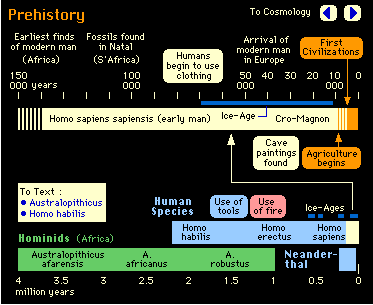
Neolithic Revolution
10,000 BC
When Civilization Begins
(Pre - History is before writing or recorded history)
The initial discovery of how to grow food, called the Neolithic
Revolution when people changed from food gatherers to food producers,
was when civilization began. Surplus, or extra food was the chief
reason for the growth of civilizations; fewer people needed to farm,
some became craftspeople, traders, and so forth, which made the
society more complex. They needed cities with governments,
division of labor, writing, calendars, advanced technical skills.
These are the 5 elements necessary for civilizations to keep going.
Even as civilizations developed, some people continued to live by
hunting and gathering, while others lived pastoral, nomadic lives.
(from http://killeenroos.com/1/neo.htm)
* * *
Australopithicus afarensis is classified as an ape, not a human.
It is a
Hominid - that is, an ape closely related to human beings.
Afarensis is a recently discovered Hominid species which lived in
north east
Africa (Ethiopia). Until 1995, this species was the earliest known
member of
the Hominid family. Fragments of more than 300 individuals of
Australopithicus afarensis have been discovered so far, including
a
remarkably complete skeleton of an adult female nicknamed 'Lucy'
Australopthicus africanus The first discovery of an early hominid
species in
Africa was by Raymond Dart who found a well preserved skull of a
juvenile in
South Africa in 1924. His discovery led to an intense focus on Africa
as the
probable site of human origins. Dart named this newly discovered
species
Australopthicus africanus, or 'Southern Ape of Africa'.
Australopithicus robustus were discovered in east and southern Africa.
These
creatures, which are now classified into several distinct species,
represent
a line of hominids which evolved along side early human species
and perhaps
interacted with them.
* * *
Homo habilis is the earliest known species of the genus Homo; that
is, the first
human species. It existed from approximately 2.2 to 1.6 million
years ago in east Africa.
Homo habilis brains are about 30% larger than those of A. africanus.
Some stone
tools , such as crude hand axes and stone flakes have been found.
They could
have been manufactured as needed or as opportunity arose. Homo habilis
was first
discovered in 1959 in the Olduvai Gorge in Tanzania.
Homo erectus is a large brained species. The tools of Homo erectus
are the first
in the fossil record to show conscious design of any complexity.
Homo erectus
may have been the first species to use and control fire. Control
of fire may
have enabled humans to move out of Africa and into colder climates
in Europe and
Asia. Tools and remains of this species have been found widely distributed
in
Europe and Asia.
Homo sapiens is the earliest forms of our own species. The surviving
physical
evidence suggests that the transition from Homo erectus to Homo
sapiens occurred
approximately 300,000 to 400,000 years ago.
Homo sapiens neanderthalensis
or 'Neanderthal Man' was a robust human species occupying Europe
and western
Asia. The Neanderthal were the first humans to live in Ice Age conditions,
surviving by hunting the largest and most formidable mammals - the
mammoth, the
rhinoceros, and wild cattle. Scientists still debate whether they
are a related
sub-species of modern humans or represent a side line of the late
Homo erectus,
related to but not ancestral to modern humans.
(from www.hyperhistory.com)